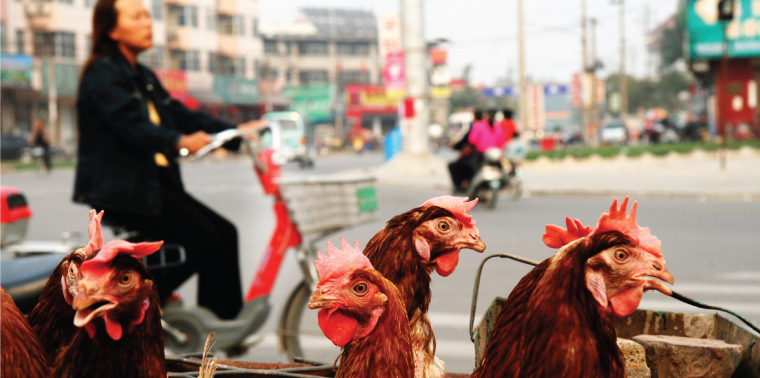June 24, 2013 — A new influenza virus strain, H7N9, surfaced this February in China, eliciting swift response and capturing headlines with concern of pandemic. As of May 29, a total of 132 confirmed cases and 37 deaths were reported. International agencies are keeping tight watch, as are China’s neighbors, with China itself deep in the epidemiological hunt, seeking the source of the virus, the mode of transmission, and insights into land use and ecological changes that might contribute to its spread. Laboratory analysis shows that genes from H7N9 are of avian origin.
This is but the most recent in a series of outbreaks of zoonotic diseases — diseases that are transmitted to humans by animals, including mad cow, H5N1, swine flu, SARS and West Nile virus. Of the diseases that have emerged or reemerged since World War II, 75 percent have been zoonotic. Driving up the risk is a global web of changes that are increasing people’s contact with natural environments and with each other — from urbanization and human encroachment on wild habitats, to expanded trade networks and greater personal mobility.
The mounting health challenge of zoonotic disease is “surprising the public, disrupting globalization, resulting in massive economic losses, and jeopardizing business and diplomatic relations,” noted a 2007 Institute of Medicine report. As silver lining, the report also spotlighted a promising approach to addressing the problem that also offers environmental benefits: One Health.
Looking at Linkages
The basic premise of One Health is that environmental, animal and human health are inextricable. The protection of one therefore requires active, coordinated monitoring and protection of all three, including integrated training of health and environmental professionals. “None of the health and environment problems we’re looking at today is solvable by one discipline,” says Steve Osofsky, executive director of wildlife health and health policy at the Wildlife Conservation Society. “And yet as professionals we’re all trained, very much, in a canalized way.”
With collaborators across the world, Osofsky is managing the Health & Ecosystems: Analysis of Linkages program. HEAL, as it’s known, is investing more than $30 million in six distinct One Health research projects, each one designed to improve public health outcomes among some of the world’s poorest people while conserving critical natural areas. Jonathan Patz, for example, a medical doctor at the University of Wisconsin–Madison, is leading an investigation into how deforestation in the Amazon affects the transmission of malaria. The World Wildlife Foundation is heading another project that seeks to understand the connection between marine protected areas and the health of coastal fishing communities. Each of the studies hopes to “robustly document linkages between intact nature and public health,” says Osofsky.
Building on previous iterations of the idea, the Wildlife Conservation Society introduced the natural environment — biodiversity, ecosystem resilience — as a third essential node connecting the health of people and animals.One Health’s push for integrative medicine is not new. The pioneering pathologist Rudolf Virchow stated in 1858, “Between animal and human medicine there is no dividing line — nor should there be.” One of Virchow’s pupils is credited with devising the inclusive term “One Medicine.” But this holistic approach lost currency amid a 20th century drive for specialization. Only in September 2004 did the Wildlife Conservation Society forcefully revive the idea at a conference held under the banner of One World, One Health. There it developed the 12 Manhattan Principles, which appealed to governments and professionals for broad recognition of, and proactive investment in, a global One Health infrastructure. Building on previous iterations of the idea, the Wildlife Conservation Society introduced the natural environment — biodiversity, ecosystem resilience — as a third essential node connecting the health of people and animals.
These principles “laid much of the modern foundation for the One Health movement,” says David Nabarro, who was appointed U.N. senior coordinator for avian and pandemic influenza in 2005.
At that time, Nabarro drew on the newly minted principles to lead the U.N. System Influenza Coordination efforts, which cast a wide net for partners in the prevention of avian and human influenza pandemics. He included experts from the U.N.’s Food and Agriculture Organisation and the World Organisation for Animal Health (OIE) alongside those from the more obviously relevant World Health Organization. Following this high-level application of One Health, the idea gained traction beyond the world of influenza, spreading to national health ministries and nonprofits, the Centers for Disease Control and Prevention and the United Nations Environment Programme, and in a formalized tripartite partnership [pdf] among the WHO, FAO and OIE.
Ensia shares solutions-focused stories free of charge through our online magazine and partner media. That means audiences around the world have ready access to stories that can — and do — help them shape a better future. If you value our work, please show your support today.
Yes, I'll support Ensia!
